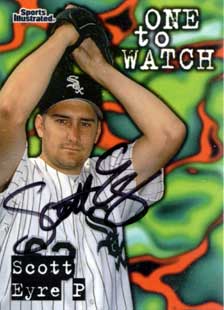 In 1929, uniform numbers appeared on the back of baseball jerseys for the first time, thanks to the Indians and the Yankees. By 1937, numbers finally appeared across all uniforms, both home and away, across both major leagues. Since that time, 81 distinct numbers have been worn by members of the White Sox, while the Cubs boast 76.
In 1929, uniform numbers appeared on the back of baseball jerseys for the first time, thanks to the Indians and the Yankees. By 1937, numbers finally appeared across all uniforms, both home and away, across both major leagues. Since that time, 81 distinct numbers have been worn by members of the White Sox, while the Cubs boast 76.
Today, we continue our look at those players, picking our favorite, if not the best, player to wear each uniform number for both Chicago teams with #28. 86 different players have donned #28 while playing in Chicago, 46 for the White Sox and 40 for the Cubs.
 Acquired by the Cubs prior to the 1989 season, Mitch Williams, wearing #28, quickly became a beloved cult figure on the north side. He made an immediate impression, giving up 3 hits to load the bases in the ninth inning on Opening Day before striking out the next three batters, starting with future Hall of Famer Mike Schmidt, to close out a one-run victory. That kickstarted an amazing season for Williams, and the Cubs, as they made a surprise run towards an NL East title. On April 28th, Williams became the only pitcher in major league history to earn a save without throwing a pitch, entering the game with two outs and picking off runner Carmelo Martinez to end the game. Williams made the All Star team for the only time in his career and hit his lone career home run, en route to a 4-4 record with 36 saves. He appeared in two games of the NLCS against the Giants, giving up the game-winning hit to Will Clark in Game 5.
Acquired by the Cubs prior to the 1989 season, Mitch Williams, wearing #28, quickly became a beloved cult figure on the north side. He made an immediate impression, giving up 3 hits to load the bases in the ninth inning on Opening Day before striking out the next three batters, starting with future Hall of Famer Mike Schmidt, to close out a one-run victory. That kickstarted an amazing season for Williams, and the Cubs, as they made a surprise run towards an NL East title. On April 28th, Williams became the only pitcher in major league history to earn a save without throwing a pitch, entering the game with two outs and picking off runner Carmelo Martinez to end the game. Williams made the All Star team for the only time in his career and hit his lone career home run, en route to a 4-4 record with 36 saves. He appeared in two games of the NLCS against the Giants, giving up the game-winning hit to Will Clark in Game 5.
1990 was not quite as good for Williams. His record dropped to 1-8 while his ERA rose to 3.93. He earned only 16 saves, a drop of 20 from the previous season, as a knee injury bothered him throughout the year. The next spring, with the Cubs having acquired Dave Smith to replace him as closer, Williams was traded to the Phillies just prior to Opening Day.
On the other side of town, Joey Cora switched to #28 after the 1991 season, his first with the White Sox. Cora spent the 1992 season on the bench following the acquisition of Steve Sax, starting only 21 games at second base. With Sax faltering, Cora became the everyday second baseman in 1993. He set a career high with 153 games played and hit .268 with a career high 20 stolen bases as the White Sox won their final AL West crown. Cora struggled in the ALCS, hitting an anemic .136 as the White Sox fell in 6 games to the Blue Jays.
Cora continued to improve in 1994, raising his average again to .276 and had 2 home runs and 30 RBIs when the season came to a premature end due to the player’s strike. When baseball resumed in 1995, Cora became a free agent and his White Sox playing career came to an end. He rejoined the organization and once again wore #28 as third base coach for the 2004 season, when Ozzie Guillen was hired as manager. He moved to became the bench coach after the 2006 season, where he would remain until the end of the 2011 season, when he was fired with 2 games left in the season as part of Guillen’s exit from the team.





